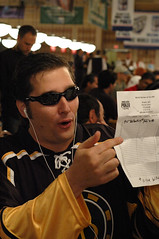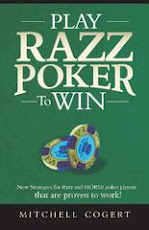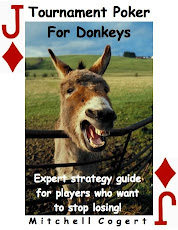 Image via Wikipedia
Image via Wikipedia
Putting My New Tournament Poker Approach to the Test: #1Sunday I went to Lucky Chances for $225 buy-in $10,000 first place guarantee event. I wanted to try out my new approach to tournaments. Unlike most events, the Lucky Chances tourney is a Re-entry one" that is, if you get knocked out in the first 4 rounds, you can buy back in. It is not your traditional rebuy format.
There were over 120 players that entered. I was lucky to start out at the "final table" since it is less likely I will be moved. I was in table 1, seat 1.
Early StagesMy starting style was to be totally passive pre-flop with all my hands, even the premium starting hands. My objective was to take on more risk, to get more chips.
The first hand: I am in the small blind for $25. They give you $5,000 to start.
Everyone folds to me. I peek at my cards and almost fall off my chair. I have QQ. I call the $50 big blind.
The big blind raises me to $125. I call.
The flop is 2-4-5 with 2 spades. I check and call a $125 bet.
The turn is another 4. I check. My opponent bets.
I figure this is the time to raise. I raise his $200 bet to $600.
He re-raises me to $1,500!! Oh no! Disaster on hand one. I make a reluctant call.
The river is a J. We both check. He shows Q-4. I lose almost half my stack on the first hand.
I continue to limp, even with A-K. I keep missing. My stack is getting lower and lower.
However, right before the break, I get back to even thanks to two key hands:
I win some chips when my Q-J gets raised by the weakest player at the table and I call. The flop comes J high. I check, call. On the turn it's check, check. And on the river since my pair is still high, I bet. My opponent folds and shows A-K.
A few hands later I'm dealt the Ac-10c in back position. I limp and the weak player on the big blind calls, as does one other player. The flop is 8 high with 2 clubs. They check, I bet and only the weak player calls. The turn is another club, giving me the nut flush. I check after my opponent. The river is a rag.
I am going to bet small hoping my opponent will call, when I notice he seems eager to call any bet. I bet the pot or $1,500 and he insta-calls. He has A-K.
Middle RoundsIn the middle rounds, my approach is not to call. Raise or fold. It works quite well and I build a nice stack.
I get lucky when I raise pre-flop with A-A and an opponent makes a move all-in with K-Q suited. I double up.
I am able to move my stack up to $15,000 in chips and we are at the $300-$600 level.
Late RoundsAfter the break, we are down to 4 tables. I need to build my stack since the blinds are now at $600-$1,200 with $100 ante. I still have about $15,000.
Under the gun, I am dealt K-K. I raise to $3,700. A player on the button with $20,000 pushes all-in. What do you think he has to make this move?
I call.
He shows Ad-Td. Oh my! What hand did he think he could beat with that play?
I am feeling good when the flop is 7-7-J with no diamonds.
I am feeling even better when the turn is a 2 of spades.
When the river is an Ace....well, I'm sick.
ConclusionI'm not sure I can take away too much from this experience. Except for the fact that the construction near the Golden Gate Bridge is so bad, it took my almost 2 hours to make a 30 minute trip back home. I may avoid Lucky Chances, and head back to the Oaks.
One final note. If I had a hand like pocket Jacks I would simply move in that last hand. The reason is that I don't mind someone going over the top when I have Kings. When I have Jacks, if I'm going to call a move all-in, it's better to move-in first.
 Image by aboutmattlaw via FlickrSuggestion for a New Tournament Poker Rule
Image by aboutmattlaw via FlickrSuggestion for a New Tournament Poker Rule













